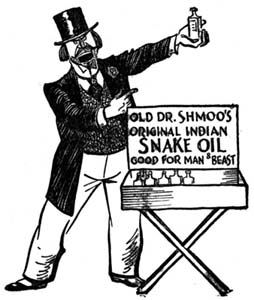Insight Marketing Blog
Search Engine Optimization Tip #1: Beware of SEO companies that use spam to promote themselves
 The vast number of emails I get from SEO companies promising to get my website on page 1 of Google is quite amazing. These firms must not be doing their homework because my website is already on page 1.
The vast number of emails I get from SEO companies promising to get my website on page 1 of Google is quite amazing. These firms must not be doing their homework because my website is already on page 1.
Most often, SEO experts who spam your inbox are snake-oil salesmen reincarnated, using unethical techniques to drive search ranking up. If you’re a novice to search engine optimization, you may be tempted to contact one of these firms – especially those who offer an enticing ploy of not charging until they achieve vague result. The problem is that in search engine optimization there is the right way (“White Hat” methods) to achieve good results, and the wrong way (“Black Hat” methods).
Black Hat Methods Can Get You Blacklisted
SEO firms that employ “black hat” methods such as keyword stuffing, hidden text, cloaked and doorway pages, link farming, and blog spamming, can indeed improve your search rankings short-term, but these techniques violate search engine terms of service, putting your website at risk of being banned. Search algorithms identify SEO trickery and will eventually blacklist your site from future searches, keeping potential customers from being able to find you. It happens every day, and quite often business don’t even realize it until much later.
Costly fees necessary to reinstate your site’s SEO status and integrity
One day your website appears on page 1 of Google and you happily pay the charlatan’s SEO fee; the next day, your website has been “blacklisted” and doesn’t appear on any search engine. Now that great deal is going to cost you more money, time and resources to correct the damage done.
The first clue a SEO firm may be unscrupulous is the fact they promote themselves via unsolicited emails; if they market their own company by using unethical spam techniques, how ethical will they be in their SEO practices to promote your company? Not very, so remain diligent and discerning when choosing a firm to do search engine optimization for your business website.
Continue reading →5 Social Media Marketing Tips to Get Started Today

Social Media needn't be overwhelming!
Back in the good ol’ days of the web (circa 2004), it was so easy for businesses to market via the internet; all that was necessary was a functional website. But the advent of social media has made a dramatic impact with online marketing— and in a good way. Social media is, for the most part, free, saving many marketing dollars. But just because it is free, doesn’t make it easy or cost-free, if your time is valuable. So before you jump into the social media frenzy, do your research and discover where your time and resources are best spent. A little research on the front end will save you a lot on the back end.
Use the Freebies
1. Use the free sites. Free, online networking services like Facebook, Twitter and LinkedIn are great marketing vehicles to post significant news, offers, promotions, and events for your business. For example, a seafood restaurant can promote $1 oysters and ½ price margaritas to loyal Twitter followers and Facebook fans.
Measure results, focus your efforts
2. Track your social media program. See which of the free social media sites are delivering results worthy of your continued efforts and focus; abandon those not measuring up to your goals.
Search Engine Optimization — It really does matter
3. Social media can also improve rankings on Google and other major search engines by building inbound links to content on your website. Learn how to optimize your website to improve how your website ranking, or hire a SEO (Search Engine Optimization) professional to do the job for you. Be sure they know how to integrate social media into your SEO program. Many times you can learn some great tips by seeing what your competition is doing and what’s working for them. Google your competition — if they appear on the search engine before you do, check out their site and compare what they are doing and you’re not.
Customers are greedy – Give them what they want
4. Customers are self-centered; they want to know: ‘what’s in it for me?’ Use social media to give customers expert advice, great links, and share valuable information. Don’t hype your business; instead create a dialogue by connecting with the customer. If you have something interesting to say, say it. Create a blog, webinar, or YouTube video to share what you know with your clients and potential clients.
Blogging is bragging!
5. Blogging helps customers find you. Comments on blogs don’t necessarily happen overnight, but your information will come up in an online search which potential clients will read, then click on to check out your website. Twittering and micro-blogging are popular now, but whichever you decide, do it regularly. Consistency wins out over content every time. Post on a regular basis; you may not necessarily get read, but your customers will see you’re out there and are current. And when they need you, you’ll be top of mind as someone to call.
Continue reading →Brand Image Lessons from BP’s Gulf Disaster
 BP Provides A Classic Case Study Of How To Screw-Up Your Brand
BP Provides A Classic Case Study Of How To Screw-Up Your Brand
As many of you know, I’m a bit obsessive about branding. In my book, Branding Insights for Small Business, I cover the essential components of an effective branding strategy every successful company achieves: creating a powerful brand image, being authentic to the core values of your business and building goodwill with your customers.
It’s never easy to transcend the signal-to-noise ratio that pervades the marketplace and launch your business or product into public consciousness, and there’s that old adage, “any news is good news.”
But what if your company is responsible for the biggest natural disaster in history? That’s a life-or-death question right now at BP. As a horrified public watches images of oil-covered wildlife, ruined coastal areas and destroyed businesses, the petroleum company that once touted itself as a progressive force in environmentalism is now trying to save the tattered remnants of its corporate reputation.
When the President accuses you of “nickel and diming,” you’ve got a image nightmare on your hands
Even BP’s damage-control efforts have backfired — the company poured $50 million into an apologetic public relations campaign, then saw its efforts backfire when reports surfaced that the company was being stingy with cash compensation for people whose homes and businesses were ruined by the oil spill. Even President Obama even got involved, accusing BP of “nickel and diming the folks down here.”
Of course, few of us are multinational executives, who run corporations operations with such far-reaching consequences. But BP’s missteps provide lessons we can all learn from:
BP spent millions advertising itself as an eco-friendly company, but had three of the largest and deadliest oil-related accidents in the past five years.
– Don’t just say you stand for something — actually STAND something. In the words of a brand strategist who wrote an op-ed for Fast Company: “Pretty logos mean nothing if your actions don’t back up what you say.” Before the oil spill, BP did a great job of positioning itself as an eco-friendly company, but as Fast Company notes, “BP has had three of the largest and deadliest oil-related accidents of the past five years.” That fact has been hammered home as repeated efforts to stop the spill have failed.
– Don’t say anything stupid. This sounds like common sense, but with an army of handlers and highly-paid public relations experts, BP’s chief executive still managed to put his foot in his mouth several times since the disaster. While BP’s share prices dropped by 30 percent and investors lost millions, CEO Tony Hayward complained, “I’d like my life back.” Earlier, he asked a New York Times reporter, “What the hell did we do to deserve this?” Sorry Tony, but when wildlife is dying and people are losing their livelihood by the thousands, people are not going to take pity on a guy who banks $8 million a year — they’re just going to get angry.
– Don’t understate things — be honest. Again, courtesy of Hayward: “The Gulf of Mexico is a very big ocean. The amount and volume of oil and dispersant we are putting into it is tiny in relation to the total water volume.” That’s a bit like saying Katrina “only” flattened one city. And it doesn’t exactly inspire confidence in oil containment efforts when the guy in charge apparently slept through his geography class.
Those are three “don’ts,” but what about the things BP should do?
That’s pretty simple — walk the talk. As I mention in my book, it’s important that your brand is built on authentic core values of the business. And these values need to permeate down to every department and employee so they know exactly what the business stands for and the promise it makes to its customers.
When BP spent millions rebranding itself as a “green” corporation a decade ago, environmental groups pointed out the company had spent more money on its image than it did on renewable energy resources. And as the story unfolds before us, it’s become obvious BP never took its responsibilities seriously beyond appearance. This is a mistake many companies make with their brand efforts: they superficially believe a marketing slogan and ad campaign will define what their company stands for. And they believe employees, shareholders and customers will simply buy into that myth. But if rumors that BP circumvented safety protocols in its deep water drilling are true, then the public backlash could be passionate and intense.
A great PR team is an essential component to any brand emergency, but it’s just as important to remember public relations is only half the battle — if a company’s actions don’t support its brand image, sooner or later that fact will be exposed, and the results could be catastrophic. Just ask Arthur Andersen.
Continue reading →